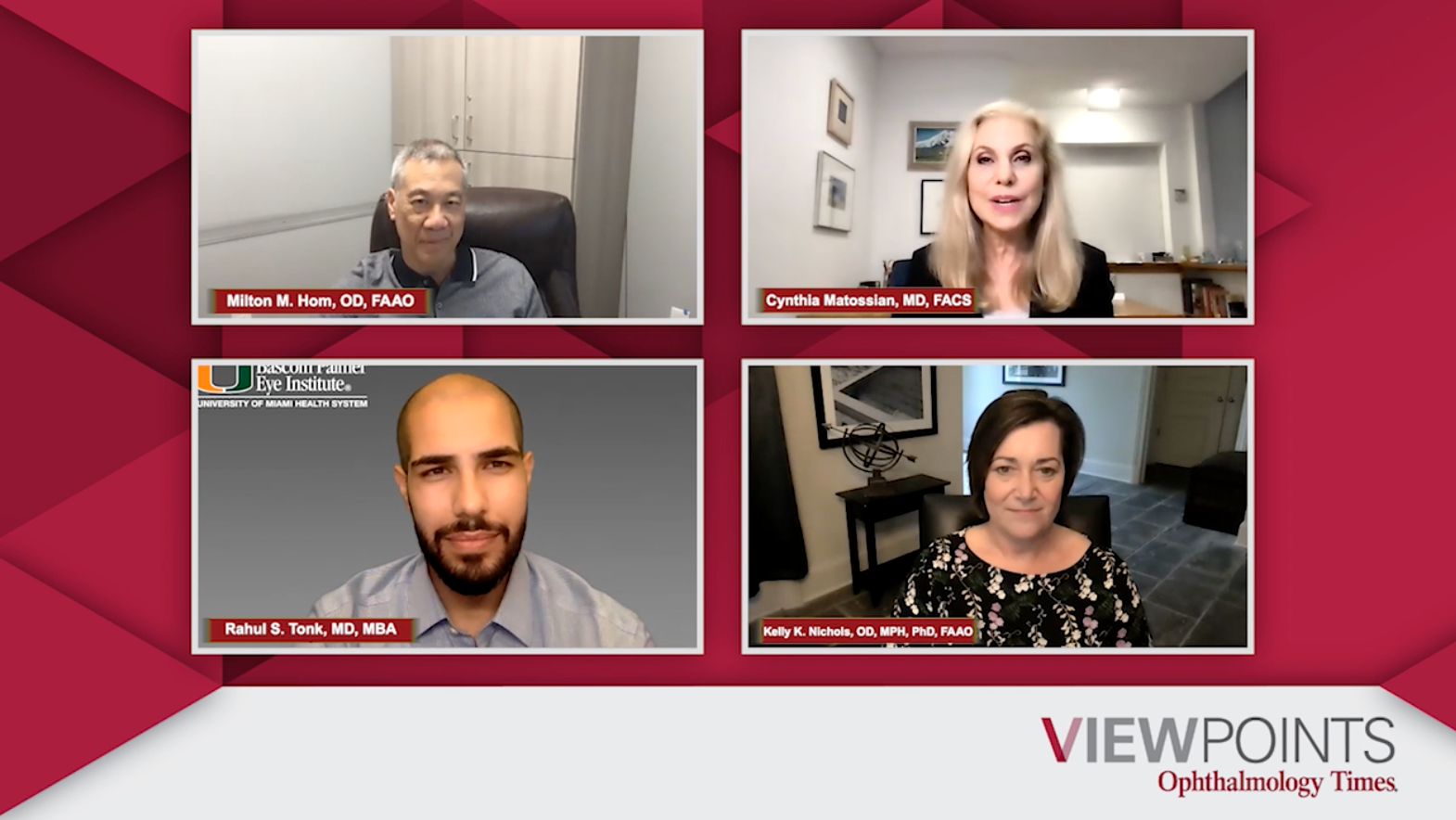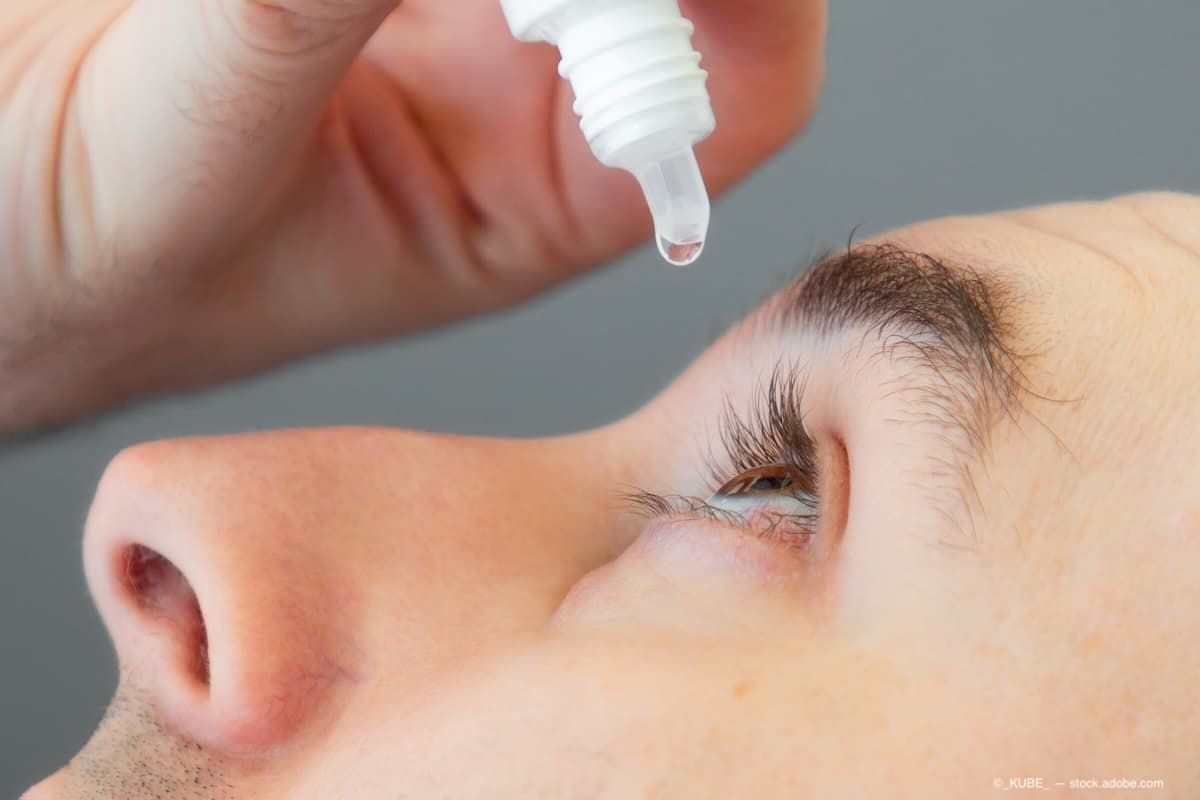Publication
Article
Digital Edition
Optimizing the management of DED
Author(s):
Experts provide perspectives on current care and pipeline products.

Matossian

Tonk

Nichols

Hom

Watch the roundtable discussion here
Management of dry eye disease (DED) was the focus of a recent tele-roundtable of experts in the field, moderated by Cynthia Matossian, MD. The panel included Milton M. Hom, OD, FAAO; Kelly K. Nichols, OD, PhD, MPH; and Rahul S. Tonk, MD, MBA.
The group reviewed the contemporary definition of DED, its causes, and the multiple ways it affects visual function and quality of life, underpinning the importance of diagnosing and treating the condition.
Reviewing the approaches for patient screening and DED detection, the participants emphasized that DED prevalence is increasing, including in younger individuals, as a consequence of increased digital screen time.
“I’ve heard some of our colleagues say to suspect dry eye in everyone until proven otherwise,” said Nichols, dean and professor at the University of Alabama at Birmingham School of Optometry.
WATCH: VIDEO: Identifying dry eye disease
The group noted that DED diagnosis does not have to be complicated. Screening for symptoms and their frequency is key, said Hom, of Canyon City Eyecare, a private practice in Azusa, California.
“There is always that question, ‘If you’re on a deserted island and you could only have 1 test for dry eye, what test would that be?’ And my first choice would absolutely be case history,” he said.
“If you have an engaging way of asking questions, a slit-lamp, and fluorescein and lissamine green vital dyes, those alone will help you diagnose basic DED,” said Matossian, founder and medical director of Matossian Eye Associates in New Jersey and Pennsylvania.
Planning therapy
The participants agreed about the importance of a thorough consultation to understand details of past therapies, to aid in identifying possible reasons for patient-perceived treatment failures.
WATCH: VIDEO: Common causes of dry eye disease
Educating patients is also critical to help them understand what to expect from recommended treatments and that additional procedures and medications may be required in the future.
Discussing specific treatment options, the group concurred that a short course of a topical corticosteroid plays a key role in quickly controlling inflammation and improving symptoms.
They noted that because of the latter benefit, treatment with a topical corticosteroid can build patient confidence in the prescriber and may improve adherence with additional therapies.
In particular, short-term treatment with a topical corticosteroid is useful as induction therapy when starting immunomodulatory treatment with cyclosporine or lifitegrast and for controlling episodic flares of DED.
Omega supplements were considered to have potential benefit, but the group highlighted the importance of making specific recommendations regarding the dose and form of omega.
Similarly, they advocated for giving patients specific recommendations for artificial tear products and instructions on frequency of use.
WATCH: VIDEO: Consequences of untreated dry eye disease
For managing meibomian gland dysfunction (MGD), which affects the majority of patients with DED, the panelists considered a dual-pronged approach as optimal.
This involves using one or more modalities to address thickened meibum and gland obstruction combined with a treatment targeting inflammation.
Showing patients slit-lamp photos, meibography images, and scores from symptom questionnaires helps them to understand their condition and document objective improvement with therapy.
“Patients like numbers. Dry eye patients want to know metrics,” Matossian said.
“We have incredible products now…. Patients can take care of their dry eye and do self-care better than ever. We just have to trust them and point them in the right direction,” said Tonk, an assistant professor of clinical ophthalmology and associate medical director at Bascom Palmer Eye Institute at the University of Miami in Florida.
WATCH: VIDEO: Evaluating patients for dry eye disease
In the pipeline
A review of products in the clinical trial phase shows a robust pipeline of investigational products for DED.
Targeting inflammation is a novel corticosteroid formulation that combines betamethasone with mycophenolic acid, which enhances the steroid’s effect to enable the use of a lower concentration of betamethasone. This product is being evaluated in phase 2 studies.
Reproxalap, which is entering into phase 3 trials, targets reactive aldehyde species that are implicated in inflammation.
Visomitin (SkQ1 eye drops) is a cardiolipin peroxidation inhibitor that reduces oxidative stress. It is also in phase 3 development.
Tanfanercept (HL036) is a TNF receptor 1 fragment that acts by decreasing the release of proinflammatory cytokines. A phase 3 study did not meet its primary end point and the company said it is currently considering further development.
WATCH: VIDEO: Educating patients about dry eye disease
Silk-derived protein-4 is a protein derived from the silkworm cocoon that has been found to have anti-inflammatory activity by downregulating nuclear factor kappa B activation. It has been studied as a topical treatment for DED in 2 phase 2 clinical trials.
PaniDrop contains PP-001, a nonsteroidal immunomodulatory small molecule, and uses nanocarrier technology to improve delivery to ocular tissues. The formulation is in early clinical development. In addition, there are 2 investigational treatments targeting increased natural tear secretion.
“We have a number of anti-inflammatory and immunomodulatory treatments already and several more in the pipeline,” Tonk said. “But I think the DED space is ripe for innovation in boosting natural tear production.”
OC-01 is a nasal spray containing the highly selective nicotinic acetylcholine receptor agonist varenicline. It stimulates natural tear production by activating the trigeminal parasympathetic pathway. OC-01 has completed phase 3 investigation.
AR-15512, which activates the TRPM8 receptor, may relieve surface discomfort and stimulate tear production. A phase 2b study of the product is currently under way.
WATCH: VIDEO: Laying therapy for dry eye disease
The pipeline also includes novel agents for treating MGD. AZR-MD-001 is a keratolytic agent targeting impacted meibum that is being investigated in a phase 2 study.
NOV03 (100% perfluorohexyloctane) is being studied in a second phase 3 trial as a treatment for MGD. It stabilizes the lipid layer of the tear film to reduce evaporation and penetrates the meibomian glands where it is thought to improve the quality of meibum secretions.
ECF843, another novel investigational agent, is a recombinant form of human lubricin being investigated in a phase 2 study. The agent aims to increase the level of lubricin, a naturally occurring glycoprotein with lubricating properties that is reduced in dry eye.
“We should keep our eyes on the pipeline. In the meantime, keep the approach to diagnosis and treatment simple, ask questions, look, and then do something,” Nichols said. “Use treatments in a sequential order and explain them very well to your patients to encourage [adherence].”
Watch more of this panel discussion
About the participants
Cynthia Matossian, MD
E: cmatossian@cmassociatesllc.net (moderator)
Matossian is a consultant to Allergan, Novartis, and Sun.
Rahul S. Tonk MD, MBA
E: rtonk@miami.edu
Tonk has no relevant financial interests to disclose.
Kelly K. Nichols, OD, PhD, MPH
E: nicholsk@uab.edu
During the past year, Nichols has consulted for and/or received honoraria from Aerie, Allergan, Bruder, Dompé, HanAll Biopharma, Kala, Novartis, Osmotica, Oyster Point, Sight Sciences, Tarsus, Thea, Tear Film Innovations/Alcon, TearSolutions, TopiVert, and Visionology, and received research funding from Allergan, Kala, and TearScience.
Milton M. Hom, OD, FAAO
E: eyemage2@gmail.com
During the past year, Hom has consulted for and/or received honoraria from Aldeyra Therapeutics, Allergan, Aperta Biosciences, AstaReal Inc, Aurinia Pharmaceuticals, Azura Therapeutics, Bausch Health, Eyenovia Bio, Eyevance Pharmaceuticals, Hovione Scientia, Kala Pharmaceuticals, Nevakar Inc, Novartis, SilkTech, Sun Pharma, Surface Pharmaceuticals, Syndexis, Tarsus Pharmaceuticals, Théa Laboratories, Topcon, Visus Therapeutics, and Vyluma.

Newsletter
Don’t miss out—get Ophthalmology Times updates on the latest clinical advancements and expert interviews, straight to your inbox.




